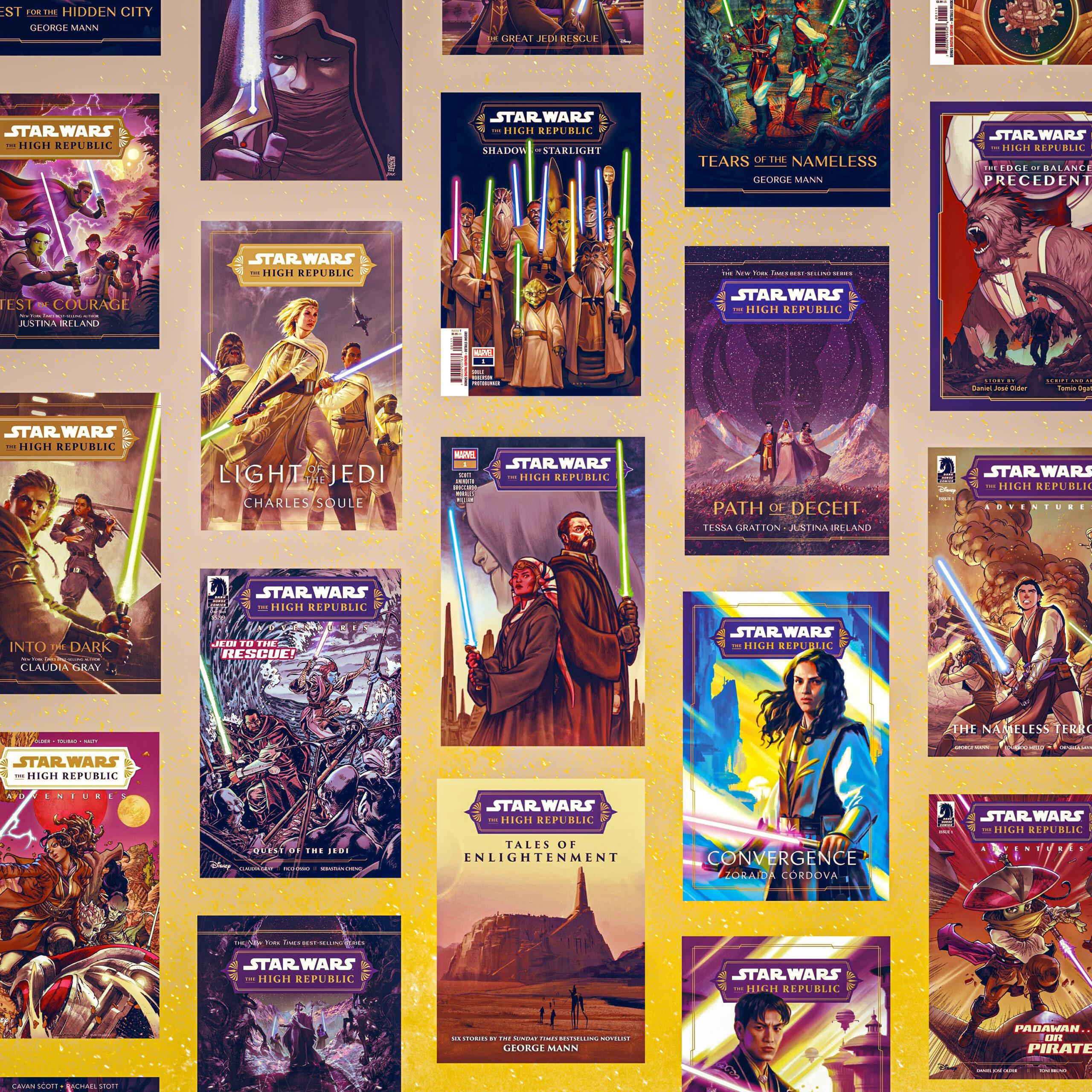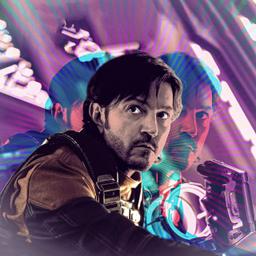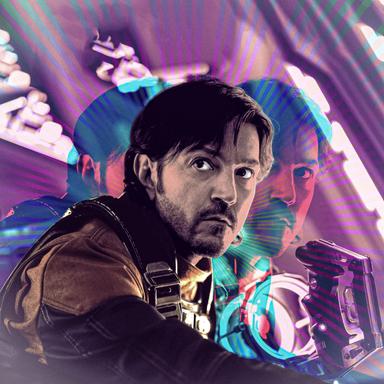
There are, and always have been, two distinct Star Wars fan bases: The one that watches Star Wars stories, and the one that reads Star Wars stories.
Like almost all “There are two kinds of ________” statements, that one is an oversimplification. The “watches Star Wars” tent encompasses movie-only loyalists (tough times for them), TV viewers (further subdivided into followers of live action and animation), and gamers. The “reads Star Wars” umbrella encompasses people who prefer novels, comics, short stories, and so on.
There’s no strict separation between the two high-level groups: Plenty of people belong to both, though it’s generally less common for Star Wars watchers to be readers than the other way around. (Huttese subtitles don’t count.) Like the dual sides of the Force, though, these parallel fictional universes have always coexisted and overlapped with each other. The first Star Wars novel and comic came out before the first film did.
Of course, Star Wars made its bones on the big screen, where it also—directly, via the box office, or indirectly, via toy sales—made much of its money. And these days, Disney+ streaming series are the foundation of the franchise. But Star Wars publishing is a voluminous, popular, and lucrative entity unto itself. Not that printed Star Wars stories stay sequestered on the page: In many cases, they cross over to the big and small screens, at which point the most mainstream of Star Wars audiences discover that there’s a whole galaxy out there beyond the best-known depictions of the Star Wars universe.
On TV and, even more so, in theaters, the pace of Star Wars has (perhaps mercifully) slowed. Excluding the last two episodes of the sadly little-watched Skeleton Crew, which concluded its run in January, Andor Season 2 is this year’s only live-action release. And aside from the upcoming third seasons of animated series Visions and Young Jedi Adventures, on-screen Star Wars programming for 2025—which also included the Tales of the Underworld miniseries—ended with Andor in mid-May.
However, Andor’s pitch-perfect conclusion isn’t the only meaningful finale to grace Star Wars storytelling this year. Last month marked the release of Trials of the Jedi, the final novel of the final phase of Lucasfilm and Del Rey’s The High Republic publishing initiative, which will officially wrap up on July 30 with a one-shot comic called, aptly enough, “The Finale.” That issue will bring an end to a sprawling narrative tapestry that spanned hundreds of releases, in many media, over three jam-packed phases, which rolled out over a four-and-a-half-year period that began with the arrival of the bestselling novel Light of the Jedi in January 2021. Although there’s been a surfeit of Star Wars on Disney+ over the past several years, one could watch it all in a tiny fraction of the time it would take to consume The High Republic’s off-screen corpus.
The High Republic, which is set hundreds of years before the Skywalker saga, during the heyday of the Republic and the Jedi, has already cross-pollinated a number of visually oriented titles. Last year’s The Acolyte was set at the tail end of the High Republic era, though its story took place more than a century after the spine of the books and comics, and had little relation to their events. The 2023 game Jedi: Survivor was suffused with High Republic lore. The Tales From the Galaxy’s Edge VR experiences and the Young Jedi Adventures cartoon are ostensibly situated in the High Republic era, though they aren’t integrally tied to it. Star Wars Eclipse, a game from French developer Quantic Dream, is also set during the High Republic, though Eclipse has hardly been seen since its 2021 unveiling. Other games and shows, such as Star Wars Outlaws, Skeleton Crew, and even Andor, invoke The High Republic too, whether via Easter eggs or loose allusions.
The High Republic’s plotlines and characters—no less canonical than any seen on screen—are bound to carry on in print in some form. But the legacy of the High Republic label will also seed the on-screen universe for years to come, whether in spirit or through concrete crossovers, just as a decades-old stray reference in a long-since-decanonized RPG sourcebook shaped Andor Season 2, and a long-dormant book character became the big bad of the Mandoverse. (Or, for that matter, much as Marvel and DC comics, which many Marvel and DC moviegoers don’t read, continue to fertilize the MCU and DCU.) So for Star Wars fans who have delved into The High Republic’s back catalog, as well as those who haven’t, here are five lessons Lucasfilm’s TV auteurs and moviemakers could draw from the massive Star Wars undertaking.
Be bold
Planning has not been Lucasfilm’s strong suit when it comes to TV and (especially) movies made during the Disney era. The sequel trilogy was plagued by rushed production and a frankly unfathomable lack of coordination among the writers and directors of the films, which led to narrative and tonal inconsistencies and whiplash for fans. And although there is, finally, a film on the books beyond next year’s TV transplant The Mandalorian and Grogu—Shawn Levy’s Star Wars: Starfighter, slated for May 2027—the long-term plan remains murky, with reporting from late last year suggesting that the pipeline is still clogged. Disney has overseen some excellent Star Wars since it purchased the franchise in 2012, but creative confusion and turnover have hampered the product even more than one might expect, even allowing for the inevitable complications that come with IP of the scale and stakes of Star Wars.
The High Republic hasn’t been under nearly as powerful a microscope as the movies, and a bestselling book doesn’t demand the same budget—or produce the same windfall—as a box office blockbuster. But The High Republic was still a monumental undertaking that made previous multimedia projects, such as Shadows of the Empire or The New Jedi Order series of the late 1990s and early 2000s, seem modest. And despite those grand designs and that daunting page count, it appears to have proceeded pretty smoothly and reached the desired destination.
Like one of Supreme Chancellor Lina Soh’s Great Works, The High Republic was, well, in the works for a while. The initiative, with a working title of Project Luminous, was brainstormed at a summit at Skywalker Ranch in September 2018, and teased in April 2019—more than half a year before the premieres of The Mandalorian and The Rise of Skywalker. Originally scheduled to debut in May 2020, before a pandemic-induced delay, the project was planned extensively and closely coordinated throughout.
That early High Republic blueprint evolved and expanded to encompass more creators (15 writers in total) and additional works. As a result, the conflict sometimes seems overstuffed. What starts as a story about a threat to the Republic posted by a group of pirates who can manipulate and block hyperspace routes expands to feature no fewer than three interrelated existential threats—the marauding Nihil, the carnivorous Drengir, and the all-consuming Blight. The middle phase of the saga rewinds to an even earlier period—as far as 500 years before the original trilogy—which supplies some valuable backstory and introduces a lot of intriguing lore but also saps some of the story’s momentum. The endgame depends on some magical MacGuffins. And though I prefer a variety of creative voices to a single overstretched one, The High Republic’s quality fluctuates from author to author.
All in all, though, The High Republic has in spades what I’ve suggested Star Wars moviemaking could use more of: ambition, organization, and, crucially, originality. Even when The High Republic breaks, it breaks some new ground in the process. Speaking of which …
Break the mold
The Mandoverse—envisioned as an interconnected narrative that would be told across several series and culminate in a “climactic story event”—is the closest that on-screen Star Wars has come to an interwoven, escalating saga since the sequel trilogy, even though its scope has been restricted by the scuttling of planned spinoff Rangers of the New Republic, the mothballing of Boba Fett, and The Mandalorian’s migration to the multiplex. Ultimately, though, the Mandoverse is constrained by its placement between two trilogies, the impulse to set up the somewhat mystifying sequel trilogy, and the financial pressures to deliver huge hits. Thus, its components can’t carve out a completely new era or wean themselves off the Skywalker saga’s narrative teat.
The High Republic manages both of those feats by exploring uncharted territory (as do the Jedi Wayseekers it introduces to the canon). Because it’s far removed from the less-than-70-year time frame that contains the entirety of the Skywalker saga (and, by extension, the vast majority of preexisting Star Wars material), it includes fewer narrative tethers to that period. Yes, it’s still recognizably Star Wars: blasters, lightsabers, starfighters, and so on. (Though there’s understandably not much sign of the Sith at this stage.) And a smattering of long-lived legacy characters from the films, including Maz Kanata, Yoda, Yaddle, Yarael Poof, and Oppo Rancisis, are present to varying degrees. (The Jedi Council clearly isn’t term-limited, considering that some of its members in the High Republic era are still serving in the same capacity in the prequels.) But there’s little of the sweaty, uninspired recycling that has marred so many high-profile Star Wars releases of late.
The High Republic subtly lays some groundwork for the distant prequel era by, for instance, explaining how the Jedi became more martially inclined and intertwined with the Republic, or hinting at how the Trade Federation arose. But it’s unabashedly a self-contained tale told in a stand-alone Star Wars era. And it contributes as much as it borrows, as far as technology, flora, and fauna. To wit: The Jedi Vector, a more distinctive, customized craft than the Delta-7 fighters used by the order in the prequels. Path engines, which enable travel through secret lanes of hyperspace. The Nameless (who have multiple names, but never mind that), the mysterious, tortured creatures who prey on the Living Force, and thus the Jedi who channel it. And charhounds, who are very good (and very hot) dogs.
Because the Jedi Order of the High Republic era is relatively large, if under duress, its members pursue all manner of vocations, from Wayseekers such as Orla Jareni to the investigator Emerick Caphtor and the scholar Reath Silas. And its genres run the gamut from noirish mystery, to Force philosophy and mysticism, to horror and humor, to good-old-fashioned space battles and saber duels. In The High Republic, there’s no one way to be a Jedi, or to tell a Star Wars story.
Expand the cast, expand the story
I’ve taken Star Wars (and sci-fi in general) to task for sidelining nonhuman characters, for fear of literally alienating audiences. It’s often a missed opportunity, because (fictional) alien biologies and beliefs offer good fodder for fresh storytelling. (See the Mass Effect franchise.) Perhaps that’s changing, thanks to Ahsoka’s nonhuman protagonist and antagonist—and thanks to The High Republic too.
The High Republic’s core characters skew human too: Chancellor Soh; the Jedi master trio of Stellan Gios, Elzar Mann, and Avar Kriss; newly knighted Bell Zettifar and Keeve Trennis. But because the series has space for so many characters, it also has space for many species.
My favorite High Republic character, Porter Engle, is a 300-year-old Ikkrukkian Jedi master who is, in time-honored fashion, Too Old for This Shit, but takes up his lethal blade for one more war—and a few more showdowns with Nihil general Abediah Viess, his nemesis for centuries. (If you’re looking to dabble in The High Republic, just to see if the water’s warm, try The Blade, a four-part comics miniseries about Engle and Viess, written by the masterful Charles Soule.) Engle’s and Viess’s extended lifespans and long memories—as well as the expansive scope of the series—allow for epic clashes, great regrets, and gradual character development. (If anything, I wanted more info on the formative days of the Jedi, galactic government, and hyperspace travel, but that will have to wait for James Mangold’s movie.) And even if The High Republic doesn’t quite let its Wookiee star speak, it does grant greater access to Burryaga’s inner life than most Star Wars media does with its Wookiees.
The series’ exceptional non-human creations also include the enigmatic, hilarious, sentient rock named Geode (let Star Wars be silly); the blob-shaped master OrbaLin; the talented Twi’lek master Loden Greatstorm; and the lightwhip-wielding Vernestra Rwoh, who’s much more memorable on the page than she is on The Acolyte. Not to mention Nihil head honcho Marchion Ro, the rest of his Evereni ancestors, and his henchwoman Lourna Dee. I’ve never seen these characters outside the comics (and my mind’s eye), but they’re still real to me, damn it, as much as many Star Wars characters who’ve been on screen.
By Star Wars standards, The High Republic stands out from a real-world representation standpoint too. Rwoh is aromantic and asexual, which highlights how The High Republic cast’s diversity extends to its array of sexual orientations and gender identities. Explicitly queer characters in on-screen Star Wars were nearly nonexistent before the recent introductions of Andor’s Vel and Cinta and The Acolyte’s Mother Aniseya and Mother Koril. But The High Republic includes many queer-coded characters, as well as some who identify as trans and/or nonbinary. The makeup of the characters reflects the diversity of the creators, who include queer-identifying authors Tessa Gratton and Alyssa Wong. Angry, toxic Star Wars fans probably reflexively review-bombed the books after reading this paragraph, but it’s a big galaxy; it should have room for folks (and folx) of all kinds.
Let Jedi form … um, attachments
When it comes to Jedi doin’ it, The High Republic is much more do than do not. Some Jedi of this era have their hands full not only of deadly attackers, but also of each other’s, um, Force-sensitive spots, or even those of hookup partners outside the order. Star Wars is still, to some extent, for kids, so the books are pretty circumspect in their descriptions of physical intimacy, leaving the tantric potential of Force-sensitive sex to the fevered fan imagination. But everyone craves connection and stress relief during difficult times, and romance and sex are in the war-torn air, from the will-they-or-won’t-they dynamic of Jedi masters Mann and Kriss to the seductive, tender team-up of Caphtor and Sian Holt.
Aren’t Jedi-on-Jedi—or Jedi-on-non-Jedi—relations heresy, according to canon? Nah, not really, despite what some of the scolds of the Skywalker saga may have said. George Lucas himself stated that Jedi aren’t celibate, though one wouldn’t know it from the movies, in which the only Jedi who gets down soon starts down the dark path to killing his wife, slaughtering younglings, and having his penis (probably?) burned/sliced off. Granted, Lucas clarified that attachment is the true pitfall for Jedi, suggesting that emotionally meaningless liaisons are fair game. But The High Republic wrestles with, and even overturns, that tenet of Jedi teaching.
The Expanded Universe has always been more liberal about Jedi lovin’ than the movies and shows, from the permissive marriage policy of the New Jedi Order to the player-controlled pairings in The Old Republic and Knights of the Old Republic. Maybe we would have seen more of the sexy side of Star Wars in The Acolyte Season 2. Alas, we’ll never know. But The High Republic makes a strong case that there’s a place for on-screen sex among Force users—not just for titillation (though there’s nothing wrong with that), but because questioning traditional teachings and testing the boundaries of behavior makes for thought-provoking depictions of the franchise’s superpowered warrior monks, and fresh insights into the nature of devoting one’s life to the Force. Mark Hamill’s headcanon went there; why can’t the actual canon?
Don’t go overboard
The most enticing aspect of The High Republic is also its most challenging: There’s so, so much of it. I tried to dive into the deep end of the saga, but after four-plus years of fairly regular reading, I feel like I’ve barely dipped my toe into the firehose. The problem is that ingesting all of the High Republic material would basically be a full-time job. And not only one that would require countless hours, but also an insatiable appetite for all kinds of content: novels and comics designed for adults, but also books and comics tailored toward young adults, middle-grade readers, and young readers; audio dramas; web series; reference books; short stories in Star Wars Insider; manga graphic novels; and more.
Immersing oneself in The High Republic and becoming a completist would doubtless be rewarding in some ways, but it would take considerable time and expense to acquire everything, let alone to peruse it. That mountain of material is intimidating, and if you’re not afraid before you begin to trek up its face, you will be once you get started. For better and worse, the various threads of the story tend to intertwine, so whatever portion of The High Republic you read, you’ll constantly encounter characters and references you won’t recognize. You’ll also have to endure a good deal of exposition about characters and events you are familiar with, placed in each book for the benefit of readers who may not be. However you try to tackle it, some significant plot points and character context will probably transpire off screen (or in this case, off page) from your perspective.
As much as I tried to keep up, I often felt a tad out of the loop and used Wookieepedia to catch up—and that’s coming from an upper-percentile Star Wars nerd. Then again, judging by the continuity errors documented on the Wookieepedia entries for various High Republic books, the authors themselves had a hard time keeping some of the series’ many moving parts in order. No wonder Marvel has tried to brand some of its streaming series as more welcoming to viewers who haven’t done the required reading (or watching): Fictional universes can quickly grow unwieldy.
In other words, I probably would have gotten even more invested in The High Republic if the amount of it had been a bit more manageable—and maybe lower quantity would have lent itself to a consistently higher quality too. But that’s a balancing act that all of today’s proliferating IPs are trying to pull off, Disney’s dual moneymakers of Marvel and Star Wars foremost among them. As evidenced by this year’s light release slate on Disney+, Lucasfilm (like Marvel) has already internalized the dangers of saturation, spurred by both declining audience interest and profit-driven belt-tightening on the streaming side.
In that sense, The High Republic is a useful reminder not to overextend. But it also illustrates the need to remain restless—to experiment and innovate even (or especially) within a franchise that’s about to turn 50. And now that Lucasfilm has (sort of) struck down The High Republic on the page, it could become more powerful than you can possibly imagine. Freed from its own finite concerns, it could loom over the franchise’s future in figurative Force ghost form. And it could make its influence felt sometime soon, in a Star Wars story on a screen near you.





